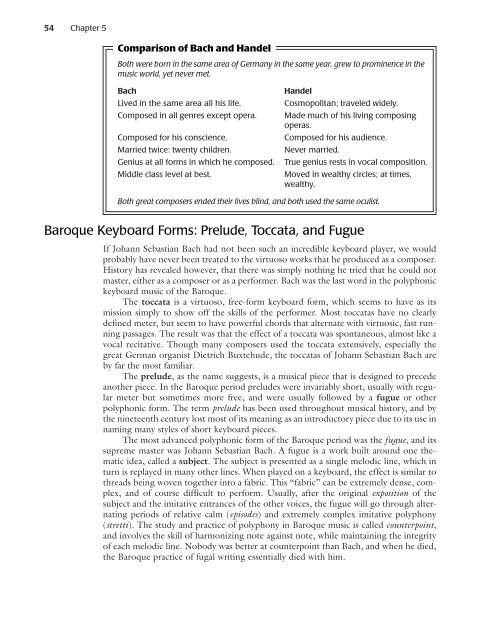Composer Profile - Activefolio
Composer Profile - Activefolio
Composer Profile - Activefolio
Create successful ePaper yourself
Turn your PDF publications into a flip-book with our unique Google optimized e-Paper software.
54 Chapter 5<br />
Comparison of Bach and Handel<br />
Both were born in the same area of Germany in the same year, grew to prominence in the<br />
music world, yet never met.<br />
Bach Handel<br />
Lived in the same area all his life. Cosmopolitan; traveled widely.<br />
Composed in all genres except opera. Made much of his living composing<br />
operas.<br />
Composed for his conscience. Composed for his audience.<br />
Married twice: twenty children. Never married.<br />
Genius at all forms in which he composed. True genius rests in vocal composition.<br />
Middle class level at best. Moved in wealthy circles; at times,<br />
wealthy.<br />
Both great composers ended their lives blind, and both used the same oculist.<br />
Baroque Keyboard Forms: Prelude, Toccata, and Fugue<br />
If Johann Sebastian Bach had not been such an incredible keyboard player, we would<br />
probably have never been treated to the virtuoso works that he produced as a composer.<br />
History has revealed however, that there was simply nothing he tried that he could not<br />
master, either as a composer or as a performer. Bach was the last word in the polyphonic<br />
keyboard music of the Baroque.<br />
The toccata is a virtuoso, free-form keyboard form, which seems to have as its<br />
mission simply to show off the skills of the performer. Most toccatas have no clearly<br />
defined meter, but seem to have powerful chords that alternate with virtuosic, fast running<br />
passages. The result was that the effect of a toccata was spontaneous, almost like a<br />
vocal recitative. Though many composers used the toccata extensively, especially the<br />
great German organist Dietrich Buxtehude, the toccatas of Johann Sebastian Bach are<br />
by far the most familiar.<br />
The prelude, as the name suggests, is a musical piece that is designed to precede<br />
another piece. In the Baroque period preludes were invariably short, usually with regular<br />
meter but sometimes more free, and were usually followed by a fugue or other<br />
polyphonic form. The term prelude has been used throughout musical history, and by<br />
the nineteenth century lost most of its meaning as an introductory piece due to its use in<br />
naming many styles of short keyboard pieces.<br />
The most advanced polyphonic form of the Baroque period was the fugue, and its<br />
supreme master was Johann Sebastian Bach. A fugue is a work built around one thematic<br />
idea, called a subject. The subject is presented as a single melodic line, which in<br />
turn is replayed in many other lines. When played on a keyboard, the effect is similar to<br />
threads being woven together into a fabric. This “fabric” can be extremely dense, complex,<br />
and of course difficult to perform. Usually, after the original exposition of the<br />
subject and the imitative entrances of the other voices, the fugue will go through alternating<br />
periods of relative calm (episodes) and extremely complex imitative polyphony<br />
(stretti). The study and practice of polyphony in Baroque music is called counterpoint,<br />
and involves the skill of harmonizing note against note, while maintaining the integrity<br />
of each melodic line. Nobody was better at counterpoint than Bach, and when he died,<br />
the Baroque practice of fugal writing essentially died with him.



